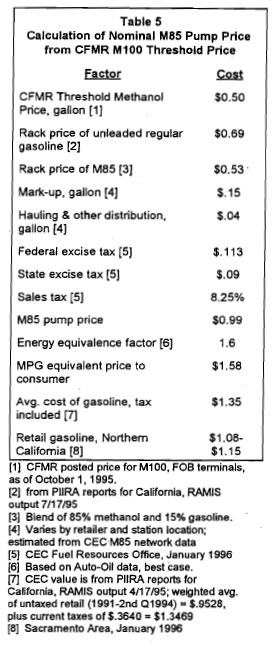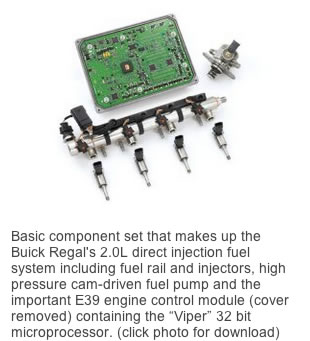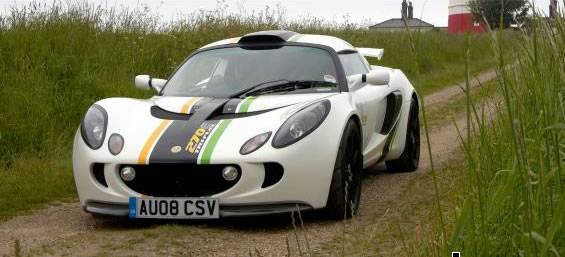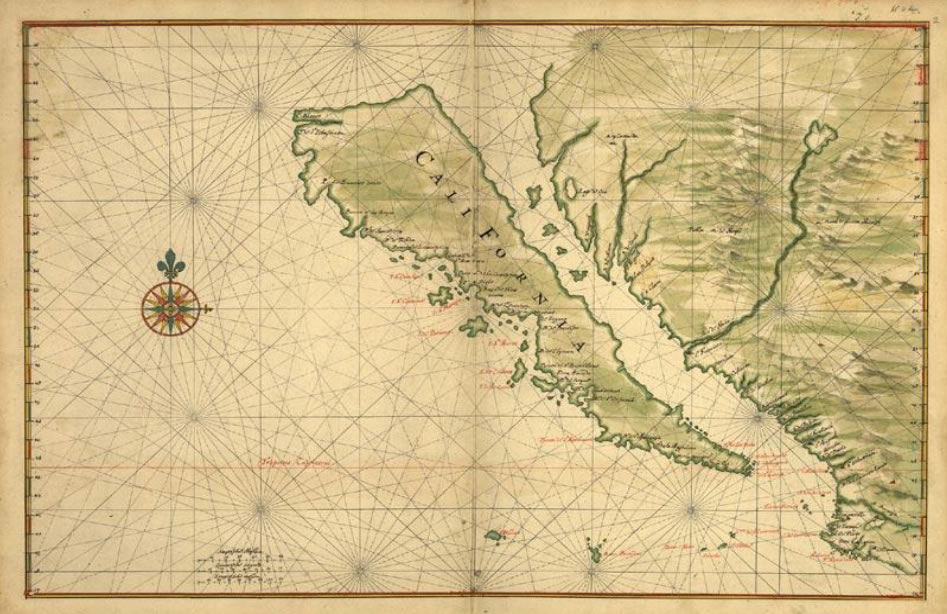California's exploratory courage sets it apart from the other 49 states, and at times leaves us with the impression that it is a separate country.
California's Methanol Fuel Experience
"The program has demonstrated the feasibility of methanol as a transportation fuel in a variety of applications." Ward and Teague 1996
The State of California has had an experimental methanol program that ran for 15 years in the 1980s and 1990s. From all we have learned thus far, it makes you think California is a separate country (map above is from Peter Ward 2012). The assessment of both state officials and of Ford motor company was that is was successful. This was in an age when vehicle on-board computers where primitive, and fuel injection was just a feature of the most advanced cars. Still all issues where successfully accommodated. Today, with the much more powerful 32 bit on-board computers, changes in timing, etc., can be made easily. Furthermore, since 10% ethanol has been added to regular grade gasoline, and the EPA has approved 15% ethanol to regular grade vehicles build from model year 2001, the issues of fuel system and valve seat wear have been drastically reduced. For Flex Fueled vehicles (so called E-85 vehicles) both of these problems have been solved for mixtures with methanol mixtures as high as 56% (Lotus Vehicle Engineering), and some say much higher. With this as background lets look at the California Methanol Fuel Experience.
1. The History
The Alternative Motor Fuel Act (AMFA) was signed into law by President Reagan in October of 1988. This became an incentive for the auto industry to invest the capital and engineering effort required to move to production of methanol-capable vehicles.
On June 12. 1989. President Bush announced a major alternative fuel vehicle program by Executive Order. which included 500,000 methanol vehicles for 1996, 750,000 for 1997, and one million per year after that. There was a government commitment to place them in the federal fleets to make this a reality.
In what follows, the summary is largely taken from the report: Peter Ward and Jonathan Teague "Fifteen Years of Fuel Methanol Distribution". http://www.methanol.org/Energy/Resources/Alternative-Fuel/CEC-1996-ISAF-Fuel-Meoh-Paper.aspx The link was viewed on JAn 31 2013. Peter was the Program Manager of the California Alternative and Renewable Fuel and Vehicle Technology Program. Additional information was obtained from Roberta Nichols "The Methanol Story: A Sustainable Fuel for the Future", Journal of Scientific & Industrial Research 62, 2003.
2. The experiments
2.1. First dedicated methanol vehicles
In 1981, Ford delivered 40 dedicated methanol fueled Escorts to Los Angeles (LA) County. Four refueling stations were installed throughout the county, including two in underground garages. The experience gained with these initial refueling stations added considerably to the knowledge base required for methanol-cornpatible infrastructure, as well as identifying the ventilation requirements for underground installations. The 200-mile driving range of the vehicle also made it clear that four stations were inadequate to cover the territorial driving requirements of LA County. But the drivers of the vehicles loved the performance, offering 20 per cent more power than their gasoline-powered cousins and a 15 per cent improvement in fuel efficiency.
2.2. the 500 car experiment
Five hundred Ford Escorts were converted to use dedicated methanol fuel. A network of 18 fueling stations was step up, and the testing began in earnest. This phase lasted two years. Overall the program was termed "a technical success". The downside was that drivers did not have enough fueling stations to be comfortable.
2.3. the advent of the Flex Fueled vehicle
To solve the above problem, Ford developed the Flex Fueled vehicle. Others were produced by GM and Chrysler. These were methanol/gasoline vehicles, up to M85.
Roberta Nichols writes; "After the Alternative Motor Fuel Act, in 1989, Ford began the transfer of the FFV technology from research to production engineering. with a target of 1993 for first production. The 3.0L Taurus was selected as a suitable vehicle, with a pilot production program (small quantity) slated for 1991 in order to add to the knowledge base acquired from the demonstration programs already in place. In keeping with this cautious approach, the 1993 production volume was limited to 2800 vehicles. with Job #1 on November 2. 1992, and gradually increasing volumes in 1994 and 1995."
"Some of the other car companies were responding to this new market as well. Chrysler set the stage for everyone by offering their flexible fuel vehicle for sale without a price premium compared to the gasoline version. even though the production costs were somewhat higher. Based on the ethanol vehicle production experience in Brazil, however, this additional cost would tend to disappear as production volumes became larger."
2.4. the 5000 car experiment.
The momentum gained from the previous fleet tests and demonstrations continued with the subsequent proposal to produce, sell and operate FFV's in one of the largest commercial alternative fuel demonstration fleets in history. These vehicles could run on up to 85% methanol (M85), just as current Flex Fueled vehicles run on up to 85% ethanol. Although M85 has 102 octane, the vehicles were tuned to work off pure gasoline, and thus could not make use of the higher octane. However, at the time the, because of the dearth of methanol filling stations, the Flex Fueled concept was a big advance, essentially eliminating the 'range anxiety' issues. Despite the fact that these vehicles were "fuel flexible", capable of operating on methanol or gasoline, it was, of course, still be essential to work with the existing fuel retailing industry to make M85 available at as many retail outlets as possible in California.
3. The Operations
The experiment was performed before any methanol distribution was available. Today, E85 an Blender pumps and dispensers are fairly common. Thus, the California Commission had to purchase all necessary equipment for each methanol fueling location. The equipment purchased included the underground storage tank, fuel dispensing pump, all product and vapor recovery lines, flame arrestors, dispenser, filter, hose, nozzle and a stand-alone fuel card reader.
4. Vehicle and Dispenser Modifications
Although all three majors of the period, Ford, General Motors and Chrysler ultimately contributed Flex Fueled vehicles, Ford Motor company played the leading role. Their most important effort in moving the experiment forward was the introduction of the Flex Fueled vehicle. This vehicle enabled motorist to avoid being stranded if they could not find a methanol service station. Roberta Nichols was the lead at Ford in this effort.
Nichols effort has since evolved in the over 11 million flexed fueled vehicles that are on the road. These have have been focused on the use of ethanol, not methanol because of the Federal Ethanol Mandate (refer to the ethanol section) the auto companies are under.
On the dispenser front, the major problem with methanol degrading the, then current, cross-linked polyethylene hoses, was solved by applying a veneer of Nylon to the inner surface of the hose. A simple development that certainly is not rocket science, and has been accomplished more than 25 years ago.
5. Oil Company cooperation
There was grudging cooperation all the way through. Let's first discuss supplying the fuel. The one exception was ARCO Petroleum, who agreed to build 25 methanol fueling facilities in California. Soon after the ARCO agreement was finalized, Chevron U.S.A. Inc. also sought and approved a similar agreement to establish and operate up to twenty-five M85 retail stations. Other companies (Mobil Oil, Exxon, Shell, Texaco and Ultrmar Refining and Marketing) entered into such cooperative agreements over the ensuing two years, leading to the establishment of some 54 publicly accessible major retailer M85 fueling sites. In addition, 13 other fueling sites were established by large fleet operators.
So as far back as 1995 all of these oil companies were able to supply the M85.
But they made life difficult in another important way. Several of the major fuel retailers did not allow the placement of methanol dispensers on the regular fueling islands. An example was the Santa Ana ARCO site where the tank was placed at the front of the facility near the fueling islands, but the dispenser and card reader position, where the actual methanol fueling took place, was relegated to the rear of the facility, in the back corner of the site next to the trash dumpster. In addition to the sitting issues, none of the retailers have undertaken marketing efforts for M85.
6. Why the California Methanol Experiment was Stopped
The price of methanol (vs. gasoline) was not favorable in the mid 1990's as it is today. The table below (Table 5 Ward and Teague) shows a comparison in 1995. Two key trouble points come out that don't exist today.

A) The first is how close the price of methanol and gasoline were. Methanol cost $.50 and gasoline rack price of $.69 per gallon. Today, of course, methanol is $1.3 and gasoline is $3.50.
B) The second is that these vehicles did not have the benefits of powerful computers, computer software and fuel injection.
C) On June 18, 1989, a major refiner announced what they called Reformulated gasoline, a blend that did not contain lead, but which, due to its benzene, toluene, and xylene could meet the octane demands with lower pollution than gasoline had up to that time. Not as low as methanol, but low enough that they could stay with petroleum that they made the most money from. It is clear that their creation of reformulated gasoline was primarily encouraged by their fear of loss of market share to methanol.
D) Furthermore, by including the, now banned, additive MTBE, which is made from methanol, they co-opted the methanol industry from moving ahead with direct methanol fuel.
In Roberta Nichols words, "The air quality benefits of methanol had become the near-term and primary driver for the programs designed to encourage its use in the transportation sector. There was a brief renewal of interest in the long-term energy issues because of Desert Storm in 1991, but mostly people had returned to a state of complacency about future oil supplies. By the middle of the decade, energy security was no longer on the "radar screen" of the California Energy Commission (CEC). Gasoline was cheap, plentiful, and reformulated."
Finally, the concept of a 'modern' electric car, which would have zero emissions captured the attention of the California legislature. Their efforts and money turned to seeing these cars on California roads.
7. The Overall Outcome
The other showstopper was pure politics. By the last 1990's the farm lobby was pushing congress for the ethanol mandate that we now have in place. So this "perfect storm" of circumstances doomed the California methanol experiment. But times have changed. All of the points above have evolved to make methanol attractive once again. And furthermore, air pollution and Greenhouse Gas issues have grown in importance.
In addition, we now blend 10% ethanol (the other alcohol) into all of our fuel, and will soon be blending 15%. There are over 11 million E85 Flex Fueled Vehicles on the road, and many experts, as noted before, like Lotus Vehicle engineering and Saab Motors have stated that these FFV can easily and safely take up to 50% methanol with no changes. How much more can they take -- this needs to be ascertained for the benefit of the country.
8. Moving Forward
Perhaps the most important outcome of the California Methanol Experiment is that Ford Motor Company's Flex Fuel Engineering prototype models were designed to run on any combination of methanol, ethanol and gasoline. But as Roberta Nichols points out; "The May 1996, Taurus was a new model and FFV production went to high volumes. This Taurus FFV was fully developed for ethanol (E85) as well. Plans were in place to move to other vehicle lines such as the Ranger pick-up truck with both M85 and E85 versions. (The production engineers did not develop the same vehicle for both fuels because the certification and validation process would have been a nightmare in terms of possible combinations of fuel). From a technical point of view. the flexible fuel vehicles were a huge success."
Of course this problem is no longer with us. With the advent of a very powerful onboard computer, all that is needed is for the software to sense the mixture using the oxygen sensor, and have the engine respond. It may not even be necessary for an alcohol sensor to be added.
With the banning of MTBE in the US, the methanol industry has been largely excluded from the US transportation industry. As noted they have looked overseas especially to China, where methanol adoption is making great headway. But it is necessary for the industry to refocus its attention towards the US. We are by far the largest users of fuel, and with the new situation it should be to their benefit.
All of the reasons that made methanol the best candidate for the long-term, widespread replacement of petroleum-based fuels back in 1980, still exist. There is a large resource base; because it is a liquid, it is the least departure from the technology in place, making it the most orderly, least expensive transition; it is environmentally friendly, since it has air quality benefits and can be made from biomass; it is a high performance, high efficiency fuel, and transparent to the customer in the internal combustion engine.
But as Nichols concludes "Most important of all, it is not likely that anything will happen unless the oil industry is a partner in the overall objectives and action plan."
8.1. Is Roberta Nichols correct in her judgment of the oil companies?
Will the oil companies get behind a large scale move to alcohol fuels? If they did, they would destroy their monopoly. It certainly appears, especially form all that we know about their history, for example not taking the lead out of gasoline, etc., etc., it's not going to happen, unless forced by the government. Thus, we feel that on this issue we need government intervention.8.2. The way to separate the auto companies from the oil companies

We are a long way towards this goal, but most of us don't know it. We know we can buy 'Third Party' chips to change the programming of the onboard computer. This means these 'Third Parties' have reversed engineered the software, and can enable us to get better performance.
But we need the auto companies to tell all of us that they have the ability to tweak the programs on their on-board computers and allow a wide range of alcohol/gasoline mixtures to be run. They need to be asked to sell us cars, not gasoline. They need to cooperate with us by establishing ranges of changes acceptable on their warranties.
The basic component needed to move ahead is to understand the software that is on the on-board computer is the key feature that needs to be changed to allow any combination of alcohols and gasoline. Yes, if we are going for a racing car like the Lotus Exige, there are other mechanical parts that could be changed to enhance performance. But just to convert to using alcohol fuels, reprogramming a computer like this would allow 10s of thousands of miles to be driven. Pictured to the left is a 32 bit microprocessor that is standard equipment on a Buick Regal Turbo Flex Fuel car, with direct-injection (the fuel rail, injectors and high pressure fuel pump are also shown). This engine is already made to use E85, and could according to Lotus use GEM mixutres with up to 40%G, 10%E and 50%M (G40, E10, M50). If the software could be reprogrammed, it could use M85, or anything in between. We need the auto companies to simply tell us why this would not be possible. And if there is a reason, tell us how much it would cost to remedy it. But on top of that because it has a turbo, this Buick Regal could make use of the 'extra' octane in the mixture (whether E85 or M85), and attain the increased horsepower and/or increased mileage.
there are other mechanical parts that could be changed to enhance performance. But just to convert to using alcohol fuels, reprogramming a computer like this would allow 10s of thousands of miles to be driven. Pictured to the left is a 32 bit microprocessor that is standard equipment on a Buick Regal Turbo Flex Fuel car, with direct-injection (the fuel rail, injectors and high pressure fuel pump are also shown). This engine is already made to use E85, and could according to Lotus use GEM mixutres with up to 40%G, 10%E and 50%M (G40, E10, M50). If the software could be reprogrammed, it could use M85, or anything in between. We need the auto companies to simply tell us why this would not be possible. And if there is a reason, tell us how much it would cost to remedy it. But on top of that because it has a turbo, this Buick Regal could make use of the 'extra' octane in the mixture (whether E85 or M85), and attain the increased horsepower and/or increased mileage.
Link to Alternative Transportation Fuels
Link to natural gas as a fuel
.


